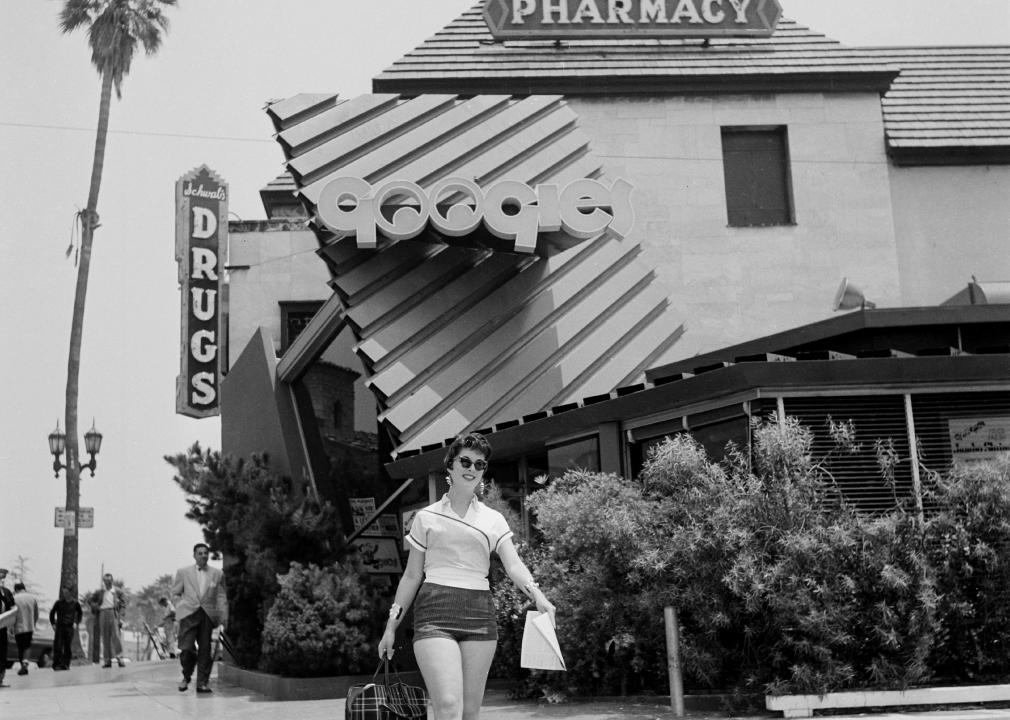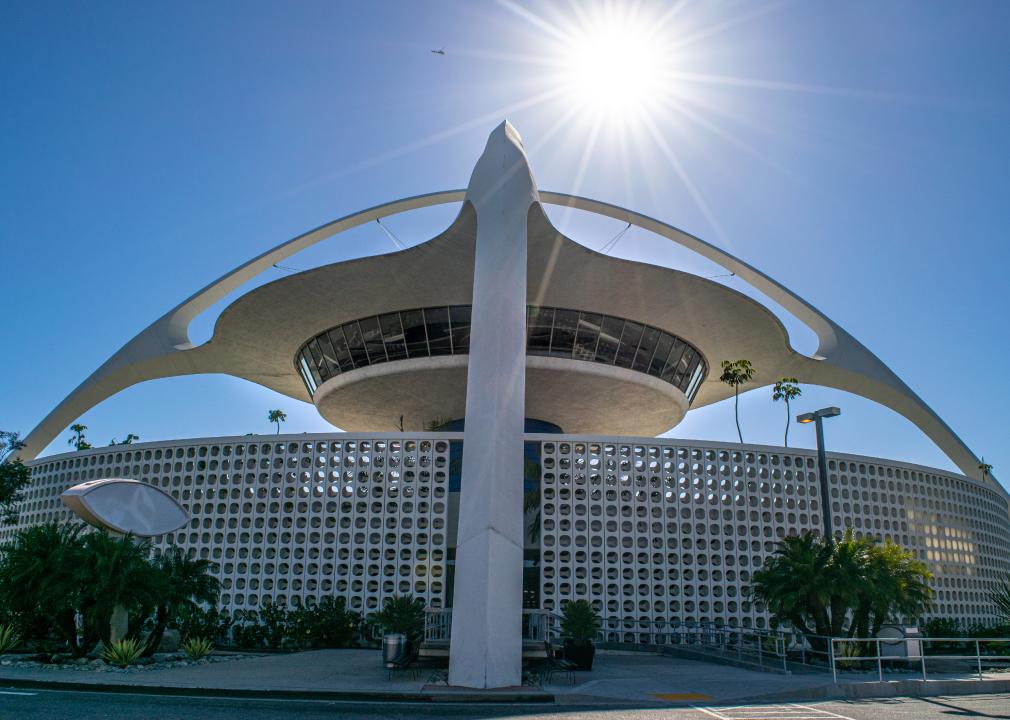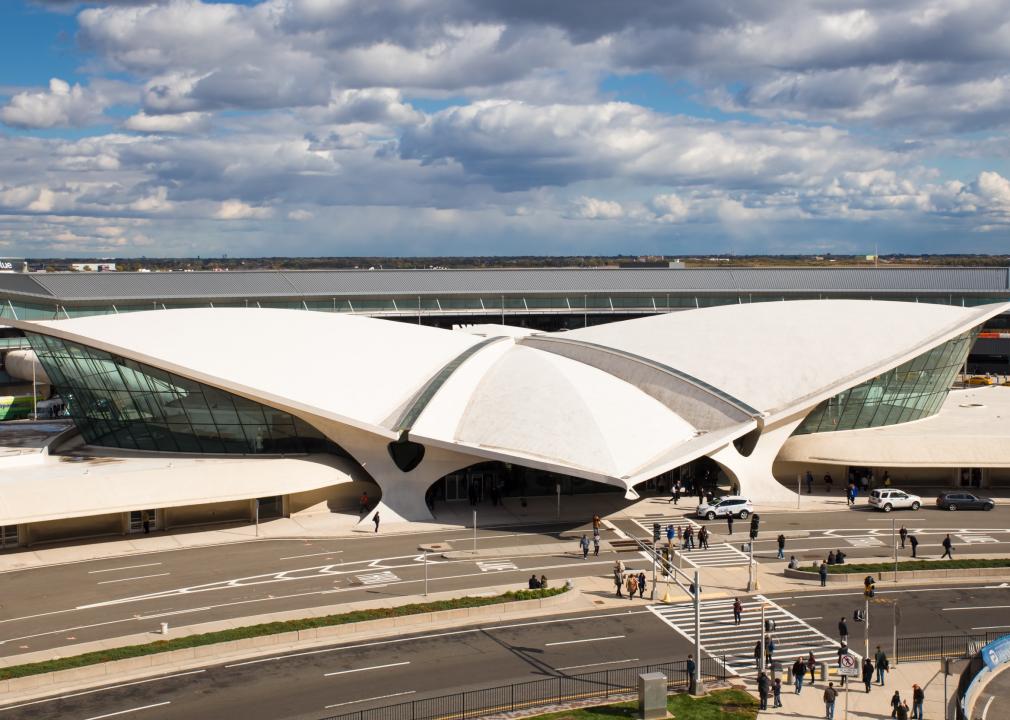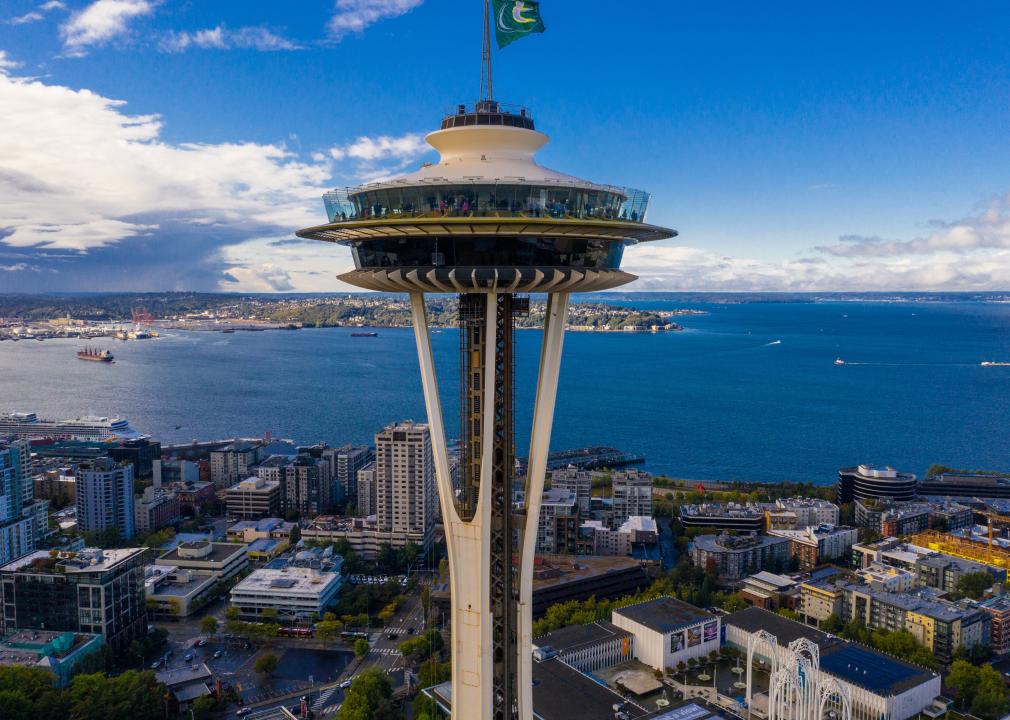The midcentury architecture of the Space Age in 5 essential Googie buildings
Michael Ochs Archives // Getty Images
The midcentury architecture of the Space Age in 5 essential Googie buildings
A woman walks outside Googies Coffee Shop and Schwab’s Pharmacy in Los Angeles.
Googie architecture touched down in Los Angeles in 1949 thanks to John Lautner’s futuristic design of the long-gone Googie’s Coffee Shop in Hollywood. Even though Lautner designed mostly private residences (like the one Gwyneth Paltrow bought in 2014), his style and fixation with the Space Age set the path for his architectural style (initially belittled by his peers) to become one of a kind.
Bold structures and upswept roofs combined with glass, neon, and fluorescent lights invaded the streets of Los Angeles and neighboring cities and later expanded to Las Vegas, Seattle, Phoenix, New York, and beyond.
From the late 1940s and far into the 1960s, roadside businesses—gas stations, motels, car washers, drive-in restaurants, coffee shops—as well as entertainment venues, like bowling alleys, cinemas, auditoriums, and even churches, started evoking flying saucers, launching pads, and airstrips, while commercial signage began displaying stars, blasts, boomerangs, parabolas, comets, and other astronomical and atomic figures.
This combination of galactic shapes with neon outlines couldn’t be ignored and would become a staple of the American midcentury lifestyle, not to mention an effective marketing tool to attract passing motorists. The golden arches of McDonald’s, originally an architectural feature of the restaurant and later the main element of its logo, were conceived during this time.
Using various architectural, design, news, and travel sources, Living Spaces chose five iconic Googie buildings that hark back to simpler times, when outer space seemed just within reach and flickering lights on the way home compelled people to imagine the future.
![]()
Logan Bush // Shutterstock
A crowd pleaser: 300 Bowl in Phoenix
Neon sign for a mid-century bowling alley.
On 300 Bowl’s opening day in 1958, ads hailed this eye-catching red-and-white structure with soaring triangular roofs as “America’s most beautiful family recreation center.”
The bowling alley and diner have been turning heads ever since, though the name of the architect who designed it remains a mystery to this day. Three exaggerated-angle rooftops reached for the sky, while large sheet glass windows brought in generous sunlight and afforded patrons a view of the outdoors surrounded by palm trees.
The building, one of the few surviving Googie-style landmarks in Phoenix, still operates today as the AMF Christown Lanes.
Nate Hovee // Shutterstock
Watch your step: Theme Building in Los Angeles
Exterior view of the Los Angeles International Airport Theme Building.
The iconic structure, which greets millions of travelers every year, was a result of a collaboration between many leading names in LA architecture: Gin Wong, a chief architect; Paul R. Williams, an American architect; and leading firms Pereira & Luckman Associates and Welton Becket & Associates.
Built in 1961, the structure was once home to a restaurant and an observation deck offering 360-degree views of the newly built airport around it. As the airport and traffic grew around the building, however, business suffered, and increased security post-9/11 made it even more difficult to roam the airport as travelers once did.
However, the building is set to take its place in the spotlight again. The city is building an elevated electric train expected to open in 2024 that will run on the north side of the iconic structure, level to its glass-enclosed body.
Currently, the Theme Building houses the Bob Hope USO organization.
littlenySTOCK // Shutterstock
Everybody lookin’ at me: TWA Flight Center in New York
View of TWA Flight Center building at JFK Airport terminal 5.
In 2019, Eero Saarinen’s landmark TWA Flight Center—originally a terminal for the defunct Trans World Airlines—was reborn as a hotel, the only one inside John F. Kennedy International Airport in New York City.
Built in 1962, Saarinen was commissioned to design not just a terminal but a grand structure representing and advertising the airline, an assignment he flourished. The terminal embodied modernity, featuring an elevated footbridge, large windows, and red velvet lounge chairs. Red carpet whisked travelers to and from the terminal.
From the outside, its aerodynamic design (a key component of Googie architecture) features a four-part thin-shell concrete rooftop composed of slanting and angled segments that, together, resemble a bird or a supersonic jet in flight.
Felix Mizioznikov // Shutterstock
Let’s spin: Space Needle in Seattle
Aerial drone image Seattle Space Needle with view of Elliott Bay.
Midcentury society’s fascination with the Space Age was crystalized at the Seattle World’s Fair in 1962. It left an eternal witness of the city’s forward-thinking spirit and a skyline icon: the Space Needle.
The 605-foot-tall structure’s UFO-shaped top features 360-degree indoor and outdoor city views and the awe-inspiring natural landscapes surrounding it. The Space Needle was first imagined by hotel executive and 1962 World’s Fair Chief Organizer Edward E. Carlson, who doodled his idea on a paper napkin. Carlson’s musings were realized by architect John “Jack” Graham Jr., who designed the top house, and architect Victor Steinbrueck, who conceived the hourglass-shaped tower based on an abstract sculpture of a woman dancer.
The Image Party // Shutterstock
Your Highness: Anaheim Convention Center in Anaheim, California
A view looking up at the front face of the Anaheim Convention Center.
In the mid-1960s, architect Adrian Wilson was entrusted with creating an eye-catching arena in Anaheim that would fit in seamlessly with the futuristic aesthetics of Disneyland’s Tomorrowland, located across the street from the multipurpose venue.
Wilson took his assignment seriously. Faithful to the reigning architectural style of the time, in 1967, he landed a spaceship among palm trees, so to speak. Anaheim was already predicted to be a tourist epicenter in Southern California by then, and the original Googie-style building boded well.
Since it opened, the convention center has hosted the likes of the Doors, Jimi Hendrix, and the “King of Rock and Roll” himself, Elvis Presley. After seven expansions over five decades, the Anaheim Convention Center spans 53 acres.
Story editing by Carren Jao. Copy editing by Paris Close. Photo selection by Clarese Moller.
This story originally appeared on Living Spaces and was produced and
distributed in partnership with Stacker Studio.











